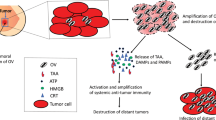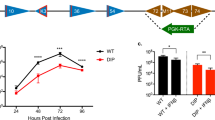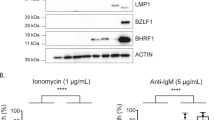Abstract
Oncolytic virotherapy is a promising avenue of cancer gene therapy. Current vectors include human viruses that have been engineered to replicate in tumor cells or nonhuman viruses that are naturally oncotropic and preferentially replicate in tumor cells harboring defects in innate immune pathways such as the type 1 interferon (IFN) pathway. Bovine herpesvirus type 1 (BHV-1) is a species-specific herpesvirus closely related to the human herpes simplex virus type 1 (HSV-1). Although BHV-1 does not efficiently replicate in and affect cellular viability of normal human cells, it is capable of infecting and killing various immortalized and transformed human cell types. Surprisingly, BHV-1 infection of human cells fails to elicit IFN production at the mRNA or protein level and the ability of BHV-1 to kill immortalized and transformed human cells does not correlate with defects in IFN pathways. Furthermore, although some cross-reactivity between BHV-1 and HSV-1 exists, the majority of human antibody or serum samples tested failed to neutralize BHV-1 despite possessing HSV-1 neutralizing capacity. Thus, BHV-1 is a novel candidate oncolytic virus with a distinct mechanism of tumor targeting.
This is a preview of subscription content, access via your institution
Access options
Subscribe to this journal
Receive 12 print issues and online access
$259.00 per year
only $21.58 per issue
Buy this article
- Purchase on Springer Link
- Instant access to full article PDF
Prices may be subject to local taxes which are calculated during checkout







Similar content being viewed by others
References
Vaha-Koskela MJ, Heikkila JE, Hinkkanen AE . Oncolytic viruses in cancer therapy. Cancer Lett 2007; 254: 178–216.
Cervantes-Garcia D, Ortiz-Lopez R, Mayek-Perez N, Rojas-Martinez A . Oncolytic virotherapy. Ann Hepatol 2008; 7: 34–45.
Stark GR . How cells respond to interferons revisited: from early history to current complexity. Cytokine Growth Factor Rev 2007; 18: 419–423.
Stojdl DF, Lichty BD, tenOever BR, Paterson JM, Power AT, Knowles S et al. VSV strains with defects in their ability to shutdown innate immunity are potent systemic anti-cancer agents. Cancer Cell 2003; 4: 263–275.
Hanahan D, Weinberg RA . The hallmarks of cancer. Cell 2000; 100: 57–70.
Stojdl DF, Lichty B, Knowles S, Marius R, Atkins H, Sonenberg N et al. Exploiting tumor-specific defects in the interferon pathway with a previously unknown oncolytic virus. Nat Med 2000; 6: 821–825.
Wang F, Ma Y, Barrett JW, Gao X, Loh J, Barton E et al. Disruption of Erk-dependent type I interferon induction breaks the myxoma virus species barrier. Nat Immunol 2004; 5: 1266–1274.
Krishnamurthy S, Takimoto T, Scroggs RA, Portner A . Differentially regulated interferon response determines the outcome of Newcastle disease virus infection in normal and tumor cell lines. J Virol 2006; 80: 5145–5155.
Hummel JL, Safroneeva E, Mossman KL . The role of ICP0-Null HSV-1 and interferon signaling defects in the effective treatment of breast adenocarcinoma. Mol Ther 2005; 12: 1101–1110.
Markert JM, Medlock MD, Rabkin SD, Gillespie GY, Todo T, Hunter WD et al. Conditionally replicating herpes simplex virus mutant, G207 for the treatment of malignant glioma: results of a phase I trial. Gene Ther 2000; 7: 867–874.
Kemeny N, Brown K, Covey A, Kim T, Bhargava A, Brody L et al. Phase I, open-label, dose-escalating study of a genetically engineered herpes simplex virus, NV1020, in subjects with metastatic colorectal carcinoma to the liver. Hum Gene Ther 2006; 17: 1214–1224.
Rampling R, Cruickshank G, Papanastassiou V, Nicoll J, Hadley D, Brennan D et al. Toxicity evaluation of replication-competent herpes simplex virus (ICP 34.5 null mutant 1716) in patients with recurrent malignant glioma. Gene Ther 2000; 7: 859–866.
Hu JC, Coffin RS, Davis CJ, Graham NJ, Groves N, Guest PJ et al. A phase I study of OncoVEXGM-CSF, a second-generation oncolytic herpes simplex virus expressing granulocyte macrophage colony-stimulating factor. Clin Cancer Res 2006; 12: 6737–6747.
Baringer JR, Swoveland P . Recovery of herpes-simplex virus from human trigeminal ganglions. N Engl J Med 1973; 288: 648–650.
Corey L, Spear PG . Infections with herpes simplex viruses (1). N Engl J Med 1986; 314: 686–691.
Parato KA, Senger DL, Forsyth PA, Bell JC . Recent progress in the battle between oncolytic viruses and tumours. Nat Rev Cancer 2005; 5: 965–976.
Jones C, Chowdhury S . A review of the biology of bovine herpesvirus type 1 (BHV-1), its role as a cofactor in the bovine respiratory disease complex and development of improved vaccines. Animal health research reviews/Conference of Research Workers in Animal Diseases 2007; 8: 187–205.
Campadelli-Fiume G, Cocchi F, Menotti L, Lopez M . The novel receptors that mediate the entry of herpes simplex viruses and animal alphaherpesviruses into cells. Rev Med Virol 2000; 10: 305–319.
Sloan KE, Eustace BK, Stewart JK, Zehetmeier C, Torella C, Simeone M et al. CD155/PVR plays a key role in cell motility during tumor cell invasion and migration. BMC Cancer 2004; 4: 73.
Murata T, Takashima Y, Xuan X, Otsuka H . Growth behavior of bovine herpesvirus-1 in permissive and semi-permissive cells. Virus Res 1999; 61: 29–41.
Hammon WM, Yohn DS, Casto BC, Atchison RW . Oncolytic Potentials of Nonhuman Viruses for Human Cancer. I. Effects of Twenty-Four Viruses on Human Cancer Cell Lines. J Natl Cancer Inst 1963; 31: 329–345.
Abril C, Engels M, Liman A, Hilbe M, Albini S, Franchini M et al. Both viral and host factors contribute to neurovirulence of bovine herpesviruses 1 and 5 in interferon receptor-deficient mice. J Virol 2004; 78: 3644–3653.
Wang F, Gao X, Barrett JW, Shao Q, Bartee E, Mohamed MR et al. RIG-I mediates the co-induction of tumor necrosis factor and type I interferon elicited by myxoma virus in primary human macrophages. PLoS Pathog 2008; 4: e1000099.
Lun X, Yang W, Alain T, Shi ZQ, Muzik H, Barrett JW et al. Myxoma virus is a novel oncolytic virus with significant antitumor activity against experimental human gliomas. Cancer Res 2005; 65: 9982–9990.
Misra V, Nelson R, Smith M . Sequence of a bovine herpesvirus type-1 glycoprotein gene that is homologous to the herpes simplex gene for the glycoprotein gB. Virology 1988; 166: 542–549.
Li QX, Liu G, Wong-Staal F . Oncolytic virotherapy as a personalized cancer vaccine. Int J Cancer 2008; 123: 493–499.
Hu J, Dong CY, Li JK, Chen DE, Liang K, Liu J . Selective in vitro cytotoxic effect of human cancer cells by bluetongue virus-10. Acta Oncol 2008; 47: 124–134.
Smyth M, Symonds A, Brazinova S, Martin J . Bovine enterovirus as an oncolytic virus: foetal calf serum facilitates its infection of human cells. Int J Mol Med 2002; 10: 49–53.
Hodes ME, Morgan S, Hubbard JD, Yu PL, Lukemeyer JW . Tissue culture and animal studies with an oncolytic bovine enterovirus (bovine enterovirus 1). Cancer Res 1973; 33: 2408–2414.
Sedmak GV, Taylor MW, Mealey Jr J, Chen TT . Oncolytic effect of bovine enterovirus on mouse and human tumours. Nat New Biol 1972; 238: 7–9.
Gillet L, Dewals B, Farnir F, de Leval L, Vanderplasschen A . Bovine herpesvirus 4 induces apoptosis of human carcinoma cell lines in vitro and in vivo. Cancer Res 2005; 65: 9463–9472.
Weinmaster GA, Misra V, McGuire R, Babiuk LA, DeClercq E . Bovid herpesvirus type-1 (infectious bovine rhinotracheitis virus)-induced thymidine kinase. Virology 1982; 118: 191–201.
van Oirschot JT, Kaashoek MJ, Rijsewijk FA . Advances in the development and evaluation of bovine herpesvirus 1 vaccines. Vet Microbiol 1996; 53: 43–54.
Jordana M, Schulman J, McSharry C, Irving LB, Newhouse MT, Jordana G et al. Heterogeneous proliferative characteristics of human adult lung fibroblast lines and clonally derived fibroblasts from control and fibrotic tissue. Am Rev Respir Dis 1988; 137: 579–584.
Bright RK, Vocke CD, Emmert-Buck MR, Duray PH, Solomon D, Fetsch P et al. Generation and genetic characterization of immortal human prostate epithelial cell lines derived from primary cancer specimens. Cancer Res 1997; 57: 995–1002.
Pettaway CA, Pathak S, Greene G, Ramirez E, Wilson MR, Killion JJ et al. Selection of highly metastatic variants of different human prostatic carcinomas using orthotopic implantation in nude mice. Clin Cancer Res 1996; 2: 1627–1636.
Acknowledgements
We thank V Misra, I Fidler, J Gauldie, G Kiel and B Lichty for reagents and D Cummings for technical assistance. RMR was supported by an Ontario Graduate Scholarship. KLM was the recipient of an R&D Health Research Career Award. This work was supported by operating grants from the Ontario Institute for Cancer Research and the Canadian Breast Cancer Foundation.
Author information
Authors and Affiliations
Corresponding author
Ethics declarations
Competing interests
The authors declare no conflict of interest.
Rights and permissions
About this article
Cite this article
Rodrigues, R., Cuddington, B. & Mossman, K. Bovine herpesvirus type 1 as a novel oncolytic virus. Cancer Gene Ther 17, 344–355 (2010). https://doi.org/10.1038/cgt.2009.77
Received:
Revised:
Accepted:
Published:
Issue Date:
DOI: https://doi.org/10.1038/cgt.2009.77
Keywords
This article is cited by
-
The contribution of bovines to human health against viral infections
Environmental Science and Pollution Research (2021)
-
Designing herpes viruses as oncolytics
Molecular Therapy - Oncolytics (2015)
-
Enhanced efficacy with azacytidine and oncolytic BHV-1 in a tolerized cotton rat model of breast adenocarcinoma
Molecular Therapy - Oncolytics (2015)
-
Oncolytic bovine herpesvirus type 1 infects and kills breast tumor cells and breast cancer-initiating cells irrespective of tumor subtype
Cancer Gene Therapy (2013)



